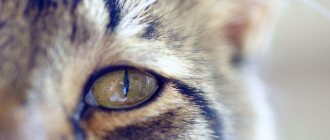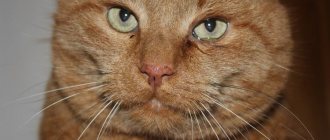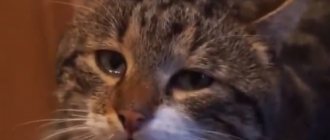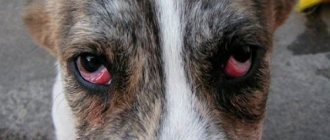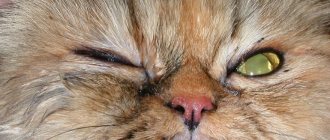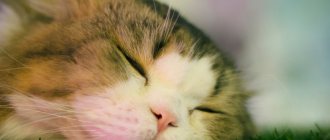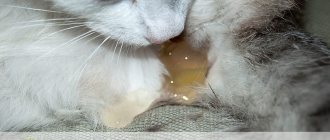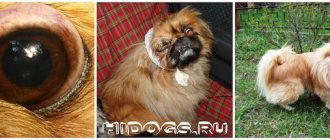12089Pavel
7
Cats are the cleanest pets, washing themselves thoroughly after each awakening. They lick the fur and use their paws to “remove” dried brownish crusts from the corners of their eyes. Usually the owner does not notice such formations, but when a cat’s eyes fester, discharge from them and souring become constant and clearly visible. This symptom is considered dangerous and should be eliminated under the supervision of a veterinarian. Why does such a pathology develop, what to do, what should be used to treat a pet whose eyes are festering? Find out the answers to these questions by reading the article.
What does purulent discharge from a cat's eyes look like?
The purulent discharge from the eyes of a cat is opaque in appearance, has a viscous consistency, and has a yellowish or greenish color, which determines the appearance of the microflora that caused the formation of pus. Depending on the amount of discharge, it can be in the corners of the cat’s eyes, form streaks on his face and dry yellowish crusts, and also form cloudy filmy deposits on the conjunctiva.
The appearance of the eye changes, the most common are:
- redness of the conjunctiva and eyelids;
- swelling of the conjunctiva and eyelids;
- prolapse of the third eyelid on the affected eye;
- blepharospasm - narrowing of the palpebral fissure caused by protective contraction of the eye muscles;
- photophobia - the cat squints the affected eye when in the light, trying to find dark places.
The animal's behavior changes:
- the cat scratches its eyes with its paws and rubs its muzzle against surrounding objects;
- blinks frequently;
- sneezes rarely if this is due to part of the discharge entering the nasal cavity through the nasolacrimal duct, and often if purulent discharge from the eyes is associated with the development of an infectious disease;
- tries to hide in dark places;
- the cat is apathetic, does not want to play, and his appetite decreases.
Purulent discharge is opaque, viscous consistency, with a yellowish or greenish tint
Symptoms
This pathology is accompanied by a number of other symptoms:
- the animal loses its appetite, becomes lethargic, sleeps longer than usual;
- temperature rises;
- due to the fact that the eyes become more sensitive to light, the cat tries to hide in a dark place;
- eyes are squinted or closed almost all the time;
- a specific smell is felt;
- a runny nose and occasional cough may appear; the mucous membrane turns red;
- anxiety appears, the cat constantly tries to rub the sore eye with its paw;
- the fur around the inflamed organ of vision darkens;
- A brown crust may form on the eyelids, preventing the eyes from opening fully.
In the presence of viral diseases, fever is observed for a long time.
Discharge can be cleaned off carefully
What diseases can cause your eyes to fester?
Purulent discharge from the eyes is a symptom of both eye diseases and general diseases.
Common diseases accompanied by purulent discharge from the eyes
Common diseases that cause cat eyes to fester:
- Allergy - at the beginning of the disease, the discharge is mucous in nature, bilateral in nature, which changes to purulent with the addition of secondary microbial flora. Additionally observed: sneezing;
- nasal discharge;
- redness of the conjunctiva;
- skin rash.
- instability of appetite;
- panleukopenia: sudden fever up to 40–41 ° C;
- fever;
- fever;
- periodic fever;
- at the very beginning of the disease, the purulent discharge is unilateral, later the second eye is affected;
Chemosis is the predominant symptom when the conjunctiva is affected by chlamydia
- fever;
- sneezing, coughing;
Photo gallery: systemic diseases in which purulent discharge from the eyes is observed
Panleukopenia causes profuse purulent discharge from the eyes and nose.
With herpetic conjunctivitis, the discharge from the eyes is purulent in nature
With chlamydia, purulent discharge from the eyes is typical, as well as chemosis - swelling of the conjunctiva
Measures to improve the condition of the conjunctiva
In case of general diseases, purulent discharge from the eyes is treated only together with the underlying pathology of which they are a symptom. To improve the condition of the eyes in case of general diseases, the following are used as part of complex therapy:
- Regular toilet of the eyes to remove pus and microbial accumulations using hygienic eye lotions: Klini;
- Veda;
- Dewdrop.
- Tsiprovet;
- tetracycline ophthalmic;
- Forvet;
Anandin is a drug that has anti-inflammatory, antiviral and immunomodulatory effects.
Table: eye diseases with purulent discharge
| Type of disease | Symptoms | Treatment |
| Eye injury |
|
|
| Conjunctivitis is an inflammation of the conjunctiva and eyelids, which is unilateral or bilateral. |
|
|
| Keratitis - inflammation of the cornea |
|
|
| Blepharitis - inflammation of the eyelids |
|
|
| Uveitis - inflammation of the choroid of the eye |
|
|
| Entropion is a chronic injury to the surface of the eye by the edge of the deformed eyelid, as well as by its eyelashes. |
| Surgical restoration of the correct position of the eyelid |
| Dacryocystitis - inflammation of the lacrimal sac |
|
|
Thus, purulent discharge from a cat’s eyes may indicate both the presence of a systemic disease and the development of eye disease. Moreover, purulent inflammation can mask the primary nature of the process and return after the use of antibiotics without treating the underlying cause of the disease.
Photo gallery: eye diseases that cause purulent discharge from the eyes
Purulent discharge from the eyes in cats most often occurs due to conjunctivitis.
Keratitis is characterized by clouding of the cornea. Dacryocystitis is characterized by swelling at the inner corner of the eye.
Entropion of the eyelid is treated surgically
Table: drugs that are used to treat eyes in cats with purulent discharge
| A drug | Compound | Operating principle | Application | Price, rubles |
| Ophthalmosan, eye drops |
| Bactericidal, anti-inflammatory, decongestant |
| 185 |
| Leopard, eye drops |
| Antibacterial agent |
Instill 1-2 drops 3-4 times a day for a course of 1-2 weeks. | 159 |
| Ciprovet, eye drops | Ciprofloxacin | Antibacterial agent |
Instill 1 drop 4 times a day for 1–2 weeks. | 196 |
| Tetracycline eye ointment | Tetracycline | Antibacterial agent | Infectious eye diseases caused by pathogens sensitive to tetracycline. Apply 3–5 times a day. | from 44 |
| Maksidin 0.15, eye drops | Germanium bis(pyridine-2,6-dicarboxylate) |
| Treatment of conjunctivitis and keratoconjunctivitis. Apply 1 drop 2-3 times a day for a course of no more than 2 weeks. | 52 per bottle |
Photo gallery for the treatment of eye diseases with purulent discharge
Sinulox is used for systemic antibacterial therapy for infectious eye diseases.
Tetracycline ointment has a broad spectrum of action and is used to treat both bacterial conjunctivitis and chlamydia
Bars eye drops are a combined antibacterial drug with an extended spectrum of action.
Korneregel promotes corneal healing
Maxidin is a veterinary drug that is used for immunocorrection in the fight against diseases of viral origin.
Dekta-2 eye drops are intended for the treatment and prevention of ophthalmic diseases of bacterial origin in pets
Ciprovet for cats is an effective antibacterial drug with a complex spectrum of action.
How to treat a cat's eyes
To carry out treatment procedures, it is better to use the help of an assistant who would hold the cat. If there is no assistant, the cat is immobilized, swaddled in a towel.
The following treatment procedures are carried out at home:
- Eye rinsing: a napkin is moistened with eye lotion or an antiseptic solution and passed over closed eyelids, removing secretions;
- if the eyelids are stuck together, a napkin richly moistened with an antiseptic solution is applied to them and lightly pressed, after which the eye will open, you cannot use force to open the eye, you can damage the eyelids;
- You cannot touch the surface of the eye with a napkin; it is washed with an antiseptic solution from a syringe, after removing the needle.
Since ointments and drops are irritating, it makes sense to wear a protective (Elizabethan) collar on the cat to prevent scratching of the eyes with its paws.
Protective collar prevents paws from scratching your eyes
Video: how to care for your pet's eyes
Diagnosis
Before making a final diagnosis, the animal is examined and its appearance is assessed. Even the owner can make a preliminary conclusion. It is necessary to record all symptoms and report them to the veterinarian, who will make an accurate diagnosis and prescribe treatment.
In a veterinary clinic, doctors use several diagnostic methods:
- wash off the secretions and take them for analysis so that specific pathogens can be identified;
- a special pigment called sodium fluorescein is instilled into the conjunctival sac. After this, the cornea is examined using a slit lamp. This method helps to identify the presence of defects, ulcers, wounds, microorganisms;
- using a slit lamp, biomicroscopy of the organ of vision is performed;
- using special express strips, determine the volume of tear fluid;
- measure intraocular pressure (a procedure necessary for diagnosing glaucoma);
- examine the fundus of the eye, examine the retina, optic nerve;
- perform an ultrasound examination.
A non-specialist independently, without using special methods, will not be able to determine what caused the appearance of pus. Accurate diagnosis in a veterinary clinic will allow you to start proper treatment on time and preserve your pet’s vision.
Inflammation causes redness and swelling
When you urgently need a doctor
A doctor is needed in all cases of purulent discharge from the eyes, when the cause is not obvious, and when purulent discharge persists for more than 2-3 days. In some situations, you should rush to visit the veterinarian, as indicated by the following symptoms:
- the appearance of fever;
- disturbance of general health: lethargy;
- apathy;
- decreased appetite.
You should consult a doctor in all cases where the cause of purulent discharge from the eyes of a cat is not obvious.
Why do adenovirus infections most often affect children?
During the first 6 months of life, children practically do not suffer from adenovirus infection. This is due to the fact that at this age children have passive immunity, inherited from their mother. Then innate immunity is lost, and children begin to get sick.
Until the age of 7 years, a child manages to get sick with adenovirus infection several times. Each time the body develops specific immunity to a specific type of adenovirus, but since there are several of them, the child has to get sick more than once. After 7 years, as a rule, they already have acquired immunity to all types of adenoviruses, and they are no longer afraid of adenovirus infection.
Over time, immunity is lost, so adenovirus infections can also affect adults.
Breed predisposition to purulent discharge from the eyes in cats
Brachycephalic cat breeds are predisposed to the appearance of discharge from the eyes, including purulent discharge. This is due to the structural features of the skull. The nasolacrimal ducts in these breeds are narrowed and curved, which helps to delay the outflow of tear fluid and cause discharge. In addition, the structure of the skull bones predisposes to the presence of chronic inflammation in the upper respiratory tract, which makes it easier for ocular discharge to become infected and become purulent.
These breeds include:
- Persian;
- Himalayan;
- exotic shorthair;
- British;
- Scottish.
Some cats of these breeds require regular help from the owner to care for their eyes in order to prevent the appearance of purulent discharge.
Brachycephalic cat breeds are predisposed to the development of purulent discharge from the eyes
Reasons for appearance
Dacryocystitis occurs in the presence of physiological pathologies, namely congenital narrowing of the duct (stenosis). Sometimes doctors detect a complete blockage of the tear duct.
- Trauma to the eyes or paranasal sinuses.
- Inflammatory process of the nose, which provokes swelling of the tissues around the eye.
- An infectious process caused by bacteria and viruses, which leads to blockage of the duct.
- Getting foreign particles into the eye or working in dusty and smoky rooms. As a result, the channel becomes clogged.
- Allergy to exposure to an irritant.
- Reduced protective properties of the body.
- Overheating and hypothermia.
- Presence of diabetes mellitus.
Very often this pathology occurs in newborn babies. This is due to the structural features of the tear ducts. When the baby is in amniotic fluid, the tear duct is closed with a special membrane, which must rupture during or after childbirth. This process does not occur if pathology occurs. Tears collect in the canal and this provokes an inflammatory process. It mainly develops in women. Men are also no exception, but this pathology is detected very rarely in them. The reason is differences in the structure of the lacrimal canal. Women use cosmetics, most of which cause inflammation.
Prevention of purulent discharge from the eyes in cats
Measures to prevent purulent discharge from the eyes in cats include:
- regular scheduled vaccinations;
- preventive administration of anthelmintics once a quarter;
- timely detection and treatment of chronic diseases and allergic conditions;
- preventive examinations by a veterinarian;
- protecting the cat from hypothermia;
- exclusion of contacts with stray animals;
- providing quality cat nutrition;
- regular wet cleaning of the premises where the cat is kept;
- Monitoring the condition of your cat's eyes.
What to do to treat an adult?
Stay up to date! The diagnosis of conjunctivitis can only be made by an ophthalmologist during an examination and based on tests.
The effectiveness of the prescribed treatment depends on the accuracy of the diagnosis.
Treatment of colds in adults must be approached with special responsibility and only after visiting a doctor.
Since similar symptoms can occur with increased intracranial pressure or if a foreign object gets into the eye.
General approach
For colds of conjunctivitis, doctors advise comprehensive treatment .
